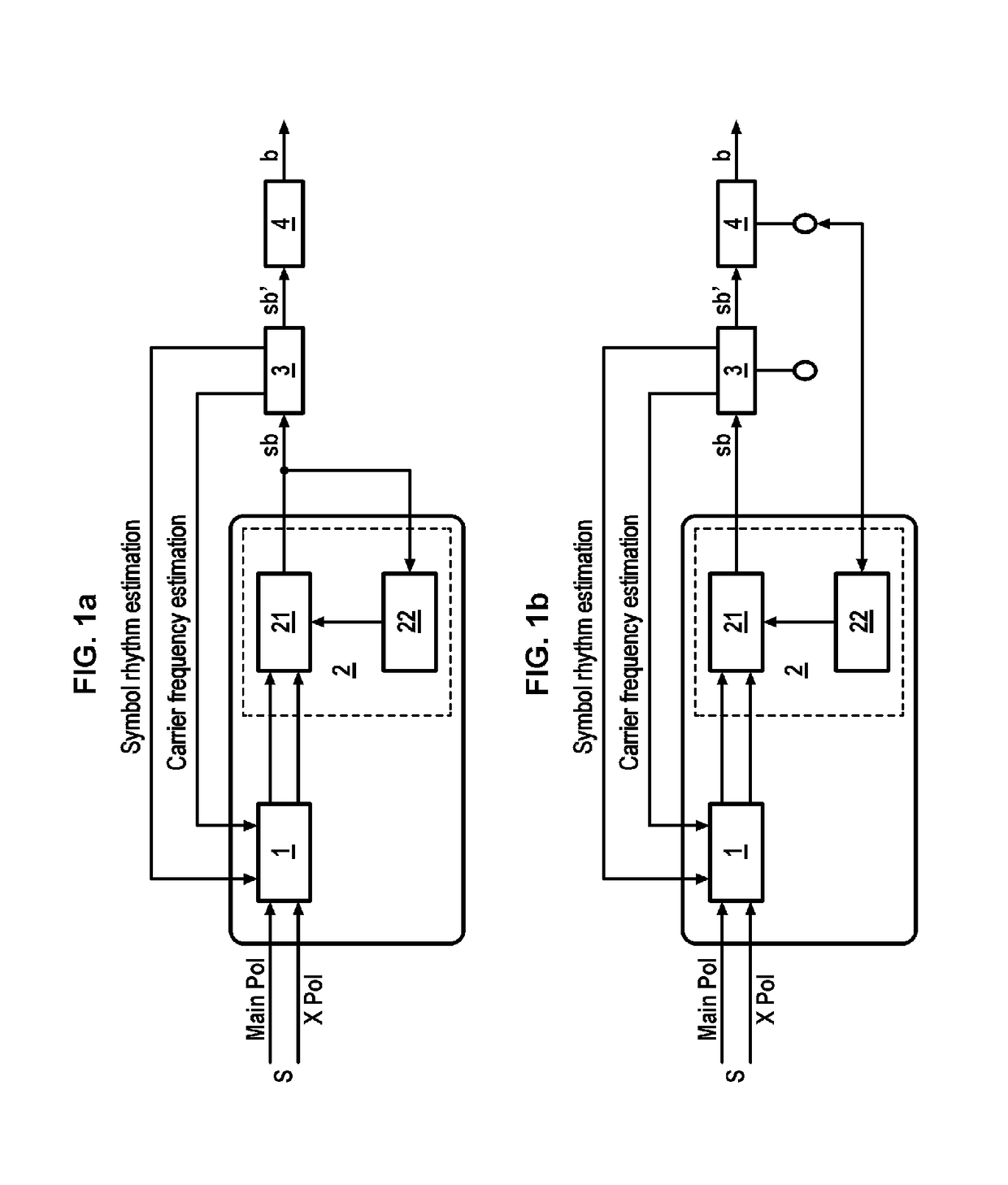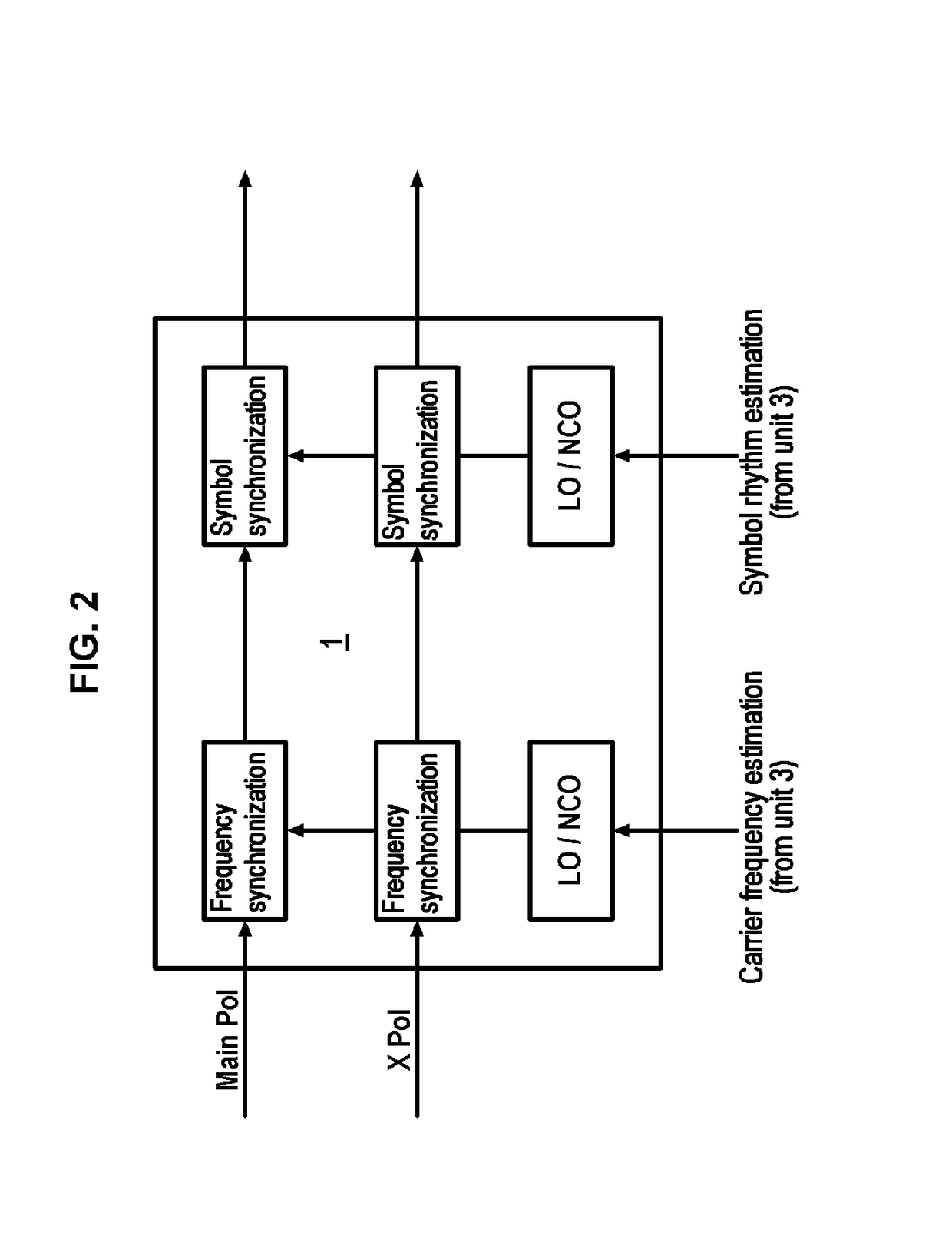Radio Communication Receiver Cancelling Out The Cross Polarisation Of A Received Signal
a radio communication receiver and cross polarisation technology, applied in the field of digital receivers, can solve the problems of interference degrading the bit error rate at reception, and affecting the operation of transmission techniques. the effect of variable envelope modulation
- Summary
- Abstract
- Description
- Claims
- Application Information
AI Technical Summary
Problems solved by technology
Method used
Image
Examples
first embodiment
[0086]FIG. 1a illustrates a receiver where the cancellation unit 2 of the interference functions in blind mode without need for a demodulation unit 3. According to this first embodiment, the filters at any given time are estimated from the filtered signal at output of the filtering unit 2) the preceding instant.
[0087]FIG. 1b illustrates a receiver where the cancellation unit 2 of the interference takes at its input a signal coming from the demodulation unit 3 or a signal coming from the decoding unit 4.
[0088]According to a second embodiment, the cancellation unit 2 of the secondary polarisation takes at its input a signal coming from the demodulation unit 3 so as to calculate its error signal updating its filter by maximising the signal-to-noise ratio and / or its signal-to-distortion ratio channel. In this second embodiment, it is the symbols filtered by the adapted filter of the demodulation unit 3 which are used for estimating the filters of the estimation unit 22 of the filter.
third embodiment
[0089] the filters of the estimation unit 22 of the filter are estimated from the information symbols affected by probability (symbols sb′).
[0090]In FIG. 1b the interrupter returning the symbols is positioned on the decoding unit 4 or on the demodulation unit 3. When it is on the demodulation unit 3 this corresponds to the second or third embodiment depending on viewpoint after the adapted filter or after equalisation and supple demapping symbol.
[0091]With respect to the second and third embodiments, it is said that the receiver is in non-blind mode, or Data Aided or at a minimum the constellation of the signal is known so that it is synchronised correctly in the region of the receiving unit 1, and the filter is correctly estimated. In such a case, the received signal comprises expected symbols which can retrieve the rhythm or frequency information supplied to the receiving unit 1. These symbols could be used in the second embodiment. Therefore, for these embodiments relative to the...
fourth embodiment
[0092] the filters are estimated from the extrinsic information symbols b at output of the decoding unit 4.
[0093]With respect to the fourth embodiment, estimation of the filter is done by methods known as iterative consisting of minimising the error probability represented by the extrinsic information of the unit 4, the algorithm BCJR could for example be used, or backward-forward.
[0094]Also, the coefficients of filters are regularly corrected by a gradient method, Newton or other converging towards the optimal solution.
[0095]According to a fifth embodiment, illustrated in FIG. 1c, the receiver is similar but the filters of the cancellation unit 2 of the secondary polarisation are estimated from the signals synchronized by the unit 1 and filtered by the filters of interest of the unit 3 duplicated in the estimation unit 22 of the filter on each of the inputs, according to FIG. 1b. This fifth mode is mathematically equivalent to the second, third and fourth embodiments in that the fi...
PUM
 Login to view more
Login to view more Abstract
Description
Claims
Application Information
 Login to view more
Login to view more - R&D Engineer
- R&D Manager
- IP Professional
- Industry Leading Data Capabilities
- Powerful AI technology
- Patent DNA Extraction
Browse by: Latest US Patents, China's latest patents, Technical Efficacy Thesaurus, Application Domain, Technology Topic.
© 2024 PatSnap. All rights reserved.Legal|Privacy policy|Modern Slavery Act Transparency Statement|Sitemap



